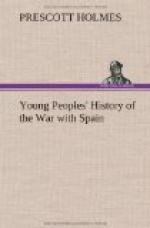The chase goes on, the guns keep up their deadly fire. Now another Spanish ship, the Vizcaya, turns to the shore, flames shooting from her decks. As she touches the beach, two loud explosions shake her from end to end. She has held her course for an hour and twenty minutes, but now she is burning on the shore.
Only one Spanish ship is left, the Cristobol Colon, flying at full speed, six miles ahead of our first ship, the Brooklyn. The Oregon and the Texas follow the Brooklyn, and the New York is only a short distance behind. For, of course, the New York, though several miles away when the race began, heard the signal gun, and turned, and flew back to Santiago on the wings of the wind. Faster and faster flies the New York, gaining rapidly in the race.
Surely, it is an exciting race, for the Colon is flying for life. Commodore Schley takes the Brooklyn farther out to sea, to head off the Colon, when she turns her course; but our other ships follow the Spaniard. There is little firing now from either side—the ships are racing.
[Illustration: Destruction of Admiral Cervera’s Fleet.]
Two hours pass in this way, and now the Brooklyn and the Oregon fire heavily at the Cristobol Colon, again and again. The helpless Colon hauls down her flag, and turns toward the shore. The last Spanish ship gives up the struggle at fifteen minutes after one o’clock, fifty miles west of Santiago.
While Commodore Schley is sending Captain Cook in a small boat to receive the surrender of the Colon, the crews of the Brooklyn and Oregon crowd upon the decks and turrets to cheer each other and shout for joy. Some of the men of the Oregon rush at once for their drums and bugles, and the notes of “The Star Spangled Banner” rise in place of the roar of the guns. The New York and the Texas arrive, and the four ships rest in triumph.
While waiting and resting, a scene took place on the Texas that will long be remembered. The captain suddenly ordered, “All hands aft!” The crew of five hundred men went to the deck to hear their captain’s message. The captain, in a few simple words, spoke to the men of his faith in the Father Almighty, and then said: “I want all of you, officers and crew, to lift your hats, and in your hearts to offer silent thanks to God.” The men were silent a few minutes, and then left the deck, giving, as they went, “Three cheers for our captain.”
[Illustration: Working the Guns on the Brooklyn.]
While the Brooklyn, Oregon, Texas, and New York were following the Cristobol Colon, our other vessels were busy saving the lives of Spaniards on board the sinking and burning ships. One small boat after another was lowered from our vessels, and the crews went to the burning vessels, where stores of powder were exploding every moment, took off the wounded Spaniards, and saved the men who had jumped into the sea and were trying to swim ashore. The work of rescue lasted




